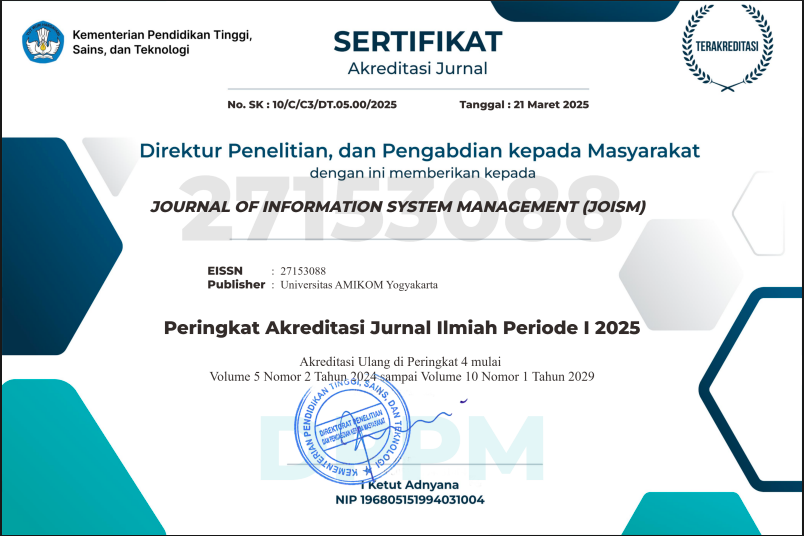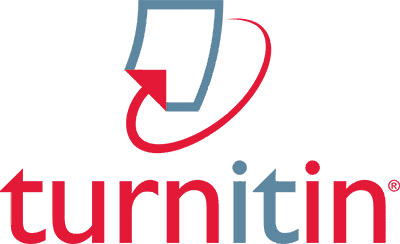ANALYSIS OF THE IMPLEMENTATION GRC INFORMATION SYSTEM IN SUPPORTING PERFORMANCE OPTIMIZATION
DOI:
https://doi.org/10.24076/joism.2023v4i2.975Keywords:
Selected:GRC Software, Delone & Mclean, UTAUT, Decision Support System, Evaluation Information SystemAbstract
The Integrated Governance and Compliance Risk Information System (SIGRC) is critical in helping institutions achieve their goals and deal with uncertainty. An Indonesian Government Agency (IGA) has used SIGRC for years. However, its utilization is still unknown. This research studies the impact of acceptance and utilization of SIGRC using Delone McLean and Unified Technology Acceptance and Use Technology. The conclusion is that the relationship between use and net benefits is unaffected. User intention on use, performance expectations on user intention, use on user satisfaction, and user satisfaction on the net benefit of SIGRC benefits are five factors that influence user satisfaction. While the expectation of use intention (ITU). Information quality with ITU. Quality of service with the use of ITU. Service quality with user satisfaction, system quality with ITU, and system quality with user satisfaction all have an influence but are not significant. This research is expected as a guideline for others to evaluate the effectiveness of SIGRC's performance.
Keywords:
GRC Software, Delone & Mclean, UTAUT, Decision Support System, Evaluation Information System
References
P. Vicente and M. M. da Silva, “A business viewpoint for integrated IT Governance, Risk and Compliance,” in Proceedings - 2011 IEEE World Congress on Services, SERVICES 2011, 2011, pp. 422–428. doi: 10.1109/SERVICES.2011.62.
H. Bala and A. Bhagwatwar, “Employee dispositions to job and organization as antecedents and consequences of information systems use,” Information Systems Journal, vol. 28, no. 4, pp. 650–683, Jul. 2018, doi: 10.1111/isj.12152.
Y. H. Chen, “Testing the impact of an information literacy course: Undergraduates’ perceptions and use of the university libraries’ web portal,” Libr Inf Sci Res, vol. 37, no. 3, pp. 263–274, Jul. 2015, doi: 10.1016/j.lisr.2015.04.002.
D. Mathew Lashayo, “Finding a Correct Measure of Information Systems: The Integration of UTAUT and Lin Model into IS Success Model,” Article in International Journal of Computer, 2018, [Online]. Available: http://ijcjournal.org/
A. Burton-Jones and D. W. Straub, “Reconceptualizing system usage: An approach and empirical test,” Information Systems Research, vol. 17, no. 3, pp. 228–246, 2006, doi: 10.1287/isre.1060.0096.
M. Shivakumar, B. D. Parameshachari, R. Banu, GSSS Institute of Engineering and Technology for Women, Institute of Electrical and Electronics Engineers. Bangalore Section, and Institute of Electrical and Electronics Engineers, 4th International Conference on Electrical, Electronics, Communication, Computer Technologies and Optimization Techniques?: ICEECCOT - 2019?: 14th & 15th December - 2018. 2018.
B. Azvine, Z. Cui, B. Majeed, and M. Spott, “Operational risk management with real-time business intelligence,” BT Technology Journal, vol. 25, no. 1, pp. 154–167, 2007, doi: 10.1007/s10550-007-0017-5.
U. S. Bititci, A. S. Carrie, and L. McDevitt, “Integrated performance measurement systems: A development guide,” International Journal of Operations and Production Management, vol. 17, no. 5. pp. 522–534, 1997. doi: 10.1108/01443579710167230.
J. J. Madlener, “The Implications of Integrating Governance, Risk and Compliance in Business Intelligence Systems on Corporate Performance Management,” 2007.
D. Otley, “Performance management: A framework for management control systems research,” Management Accounting Research, vol. 10, no. 4, pp. 363–382, Dec. 1999, doi: 10.1006/mare.1999.0115.
N. Racz, E. Weippl, and A. Seufert, “A frame of reference for research of integrated Governance, Risk and Compliance (GRC),” in Lecture Notes in Computer Science (including subseries Lecture Notes in Artificial Intelligence and Lecture Notes in Bioinformatics), 2010, vol. 6109 LNCS, pp. 106–117. doi: 10.1007/978-3-642-13241-4_11.
W. H. DeLone and E. R. McLean, “The DeLone and McLean model of information systems success: A ten-year update,” in Journal of Management Information Systems, 2003, vol. 19, no. 4, pp. 9–30. doi: 10.1080/07421222.2003.11045748.
S. Hamilton and N. L. Chervany, “Evaluating Information System Effectiveness-Part I: Comparing Evaluation Approaches,” 1981.
S. Emhmed, A.M Alim Musab, and Al-yousif Shahad, Drivers of Supporting Change to ERP. IEEE 7th Conference on System, Process, and Control , 2019.
G. Banafo Akrong, S. Yunfei, and E. Owusu, “Development and validation of an improved DeLone-McLean IS success model - application to the evaluation of a tax administration ERP,” International Journal of Accounting Information Systems, vol. 47, p. 100579, Dec. 2022, doi: 10.1016/J.ACCINF.2022.100579.
S. Mardiana, J. H. Tjakraatmadja, and A. Aprianingsih, “Validating the Conceptual Model for Predicting Intention to Use as Part of Information System Success Model: The Case of an Indonesian Government Agency,” Procedia Comput Sci, vol. 72, pp. 353–360, Jan. 2015, doi: 10.1016/J.PROCS.2015.12.150.
J. Mou and M. Benyoucef, “Consumer behavior in social commerce: Results from a meta-analysis,” Technol Forecast Soc Change, vol. 167, p. 120734, Jun. 2021, doi: 10.1016/J.TECHFORE.2021.120734.
Y. Yus and R. Jayadi, “Factors Affecting The Use Of Youtube As A Media Supporting Student Learning Performance,” 2021.
M. A. Alajmi and J. H. Alotaibi, “Reconceptualization of system use in the context of the digital library: what are the roles of UTAUT and IS success models?,” J Electron Resour Librariansh, vol. 32, no. 3, pp. 151–181, Sep. 2020, doi: 10.1080/1941126X.2020.1790943.
S. Ananda, S. Devesh, and A. M. al Lawati, “What factors drive the adoption of digital banking? An empirical study from the perspective of Omani retail banking,” Journal of Financial Services Marketing, vol. 25, no. 1–2, pp. 14–24, Jun. 2020, doi: 10.1057/s41264-020-00072-y.
V. Venkatesh, J. Y. L. Thong, and X. Xu, “Unified Theory of Acceptance and Use of Technology: A Synthesis and the Road Ahead,” J ournal, vol. 17, pp. 328–376, 2016.
J. Babarsari, “Analysis of the Application of the UTAUT (Unified Theory Of Acceptance And Use Of Technology) Model (Analisis Penerapan Model UTAUT (Unified Theory O f Acceptance And Use O f Technology)),” 2015.
G. G. Gable, D. Sedera, and T. Chan, “Re-conceptualizing information system success: The IS-impact measurement model,” J Assoc Inf Syst, vol. 9, no. 7, pp. 377–408, 2008, doi: 10.17705/1jais.00164.
A. R. A. Puspitarini, “Extended Delone & Mc Lean ISS Model To Evaluate IT Assistance Application Usage Level,” J Theor Appl Inf Technol, vol. 19, Oct. 2022.
F. Ecarnot, M. F. Seronde, R. Chopard, F. Schiele, and N. Meneveau, “Writing a scientific article: A step-by-step guide for beginners,” Eur Geriatr Med, vol. 6, no. 6, pp. 573–579, 2015, doi: 10.1016/j.eurger.2015.08.005.
H. Jogiyanto, Computer Based Information Systems: Basic Concepts and Components (Sistem Informasi Berbasis Komputer: Konsep dan Komponen Dasar). Yogjakarta: BPFEYogyakarta, 2000.
S. Mardiana, J. H. Tjakraatmadja, and A. Aprianingsih, “International Journal of Economics and Financial Issues DeLone-McLean Information System Success Model Revisited: The Separation of Intention to Use-Use and the Integration of Technology Acceptance Models,” International Journal of Economics and Financial Issues, no. 5, pp. 10–11, 2015, [Online]. Available: http:www.econjournals.com
G. B. Davis, Management Information System Basic Framework: Part II Structure and Development (Kerangka Dasar Sistem Informasi Manajemen: Bagian II Struktur dan Pengembangannya), Management Serries. 1988.
V. Cindi Monarike and D. Krisbiantoro, “Analisis Kepuasan Mahasiswa Terhadap Aplikasi Zoom Cloud Meeeting Menggunakan Model Pendekatan Technology Acceptance Model (Tam) (Studi Kasus: Mahasiswa Universitas Amikom Purwokerto),” TAM, 2022.
J. F. Hair, C. M. Ringle, and M. Sarstedt, “PLS-SEM: Indeed a silver bullet,” Journal of Marketing Theory and Practice, vol. 19, no. 2, pp. 139–152, Apr. 2011, doi: 10.2753/MTP1069-6679190202.
Wibisono Satrio, “Analysis of the Success of -Based System Implementation Erp With Delone Model Approach And Mclean at Bank Indonesia(Analisis Kesuksesan Penerapan Sistem Berbasis Erp Dengan Pendekatan Model Delone Dan Mclean Pada Bank Indonesia).,” 2021.
R. Burris and R. Howard, “The Business Process Transformation Framework A new approach to delivering your ‘to be’ vision completely, accurately, and efficiently,” 2010. [Online]. Available: www.bptrends.com
Cau David, “Governance, Risk and Compliance (GRC) software Business needs and market trends,” 2017, Accessed: Apr. 11, 2022. [Online]. Available: https://www2.deloitte.com/content/dam/Deloitte/lu/Documents/risk/lu_en_ins_governance-risk-compliance-software_05022014.pdf.
W. Sanders, Educational Evaluation: Alternative Approaches and Practical Guidelines, White Plains. New York: Pitman Publishing Inc, 1979.
U. Yudatama, A. N. Hidayanto, B. A. A. Nazief, and K. Phusavat, “Data to model the effect of awareness on the success of IT Governance implementation: A partial least squares structural equation modeling approach (PLS-SEM),” Data Brief, vol. 25, p. 104333, Aug. 2019, doi: 10.1016/J.DIB.2019.104333.
H. Abdullah, Analyzing The Technological Challenge of GRC. 2019.
J. Bosco, N. Ndushabandi, and A. N. Wausi, “ICT Governance Drivers and Effective ICT Governance at the University of Rwanda,” American Journal of Information Systems, vol. 4, no. 2, pp. 45–58, 2016, doi: 10.12691/ajis-4-2-3.
K. &Julie Kendall, System Analysis and Design Volume 1 (Analisis dan Perancangan Sistem Jilid 1), 1st ed. Jakarta: PT. Indeks Kelompok Gramedia, 2003.
V. Nissen and W. Marekfia, “Towards a research agenda for strategic governance, risk and compliance (GRC) management,” in Proceedings - 2013 IEEE International Conference on Business Informatics, IEEE CBI 2013, 2013, pp. 1–6. doi: 10.1109/CBI.2013.9.
M. Krey, “Significance and current status of integrated IT GRC in health care: An explorative study in swiss hospitals,” in Proceedings of the Annual Hawaii International Conference on System Sciences, Mar. 2015, vol. 2015-March, pp. 3002–3012. doi: 10.1109/HICSS.2015.363.
D. Ramalingam, S. Arun, and N. Anbazhagan, “A Novel Approach for Optimizing Governance, Risk management and Compliance for Enterprise Information security using DEMATEL and FoM,” Procedia Comput Sci, vol. 134, pp. 365–370, Jan. 2018, doi: 10.1016/J.PROCS.2018.07.197.
J. F. Solomon, A. Solomon, S. D. Norton, and N. L. Joseph, “A Conceptual Framework For Corporate Risk Disclosure Emerging From The Agenda For Corporate Governance Reform,” The British Accounting Review, vol. 32, no. 4, pp. 447–478, Dec. 2000, doi: 10.1006/BARE.2000.0145.
A. Okuda, “Towards E-compliance,” maastricht university, 2021. doi: 10.26481/dis.20211116ao.
L. Dittmar and P. Vogel, “Special Advertising Section Integrating GRC with Performance Management Demands Enterprise Solutions,” 2008.
E. Humphreys, “Information security management standards: Compliance, governance and risk management,” Information Security Technical Report, vol. 13, no. 4, pp. 247–255, Nov. 2008, doi: 10.1016/J.ISTR.2008.10.010.
N. F. Najwa and T. D. Susanto, “Information Technology Governance Studies and Research Opportunities: Literature Review (Kajian dan Peluang Penelitian Tata Kelola Teknologi Informasi: Ulasan Literatur),” Jurnal Teknologi Informasi dan Ilmu Komputer, vol. 5, no. 5, p. 517, Oct. 2018, doi: 10.25126/jtiik.201855827.
K. Tamilmani, N. P. Rana, S. F. Wamba, and R. Dwivedi, “The extended Unified Theory of Acceptance and Use of Technology (UTAUT2): A systematic literature review and theory evaluation,” Int J Inf Manage, vol. 57, Apr. 2021, doi: 10.1016/j.ijinfomgt.2020.102269.
Downloads
Published
Issue
Section
License
Copyright (c) 2023 Journal of Information System Management (JOISM)

This work is licensed under a Creative Commons Attribution 4.0 International License.













